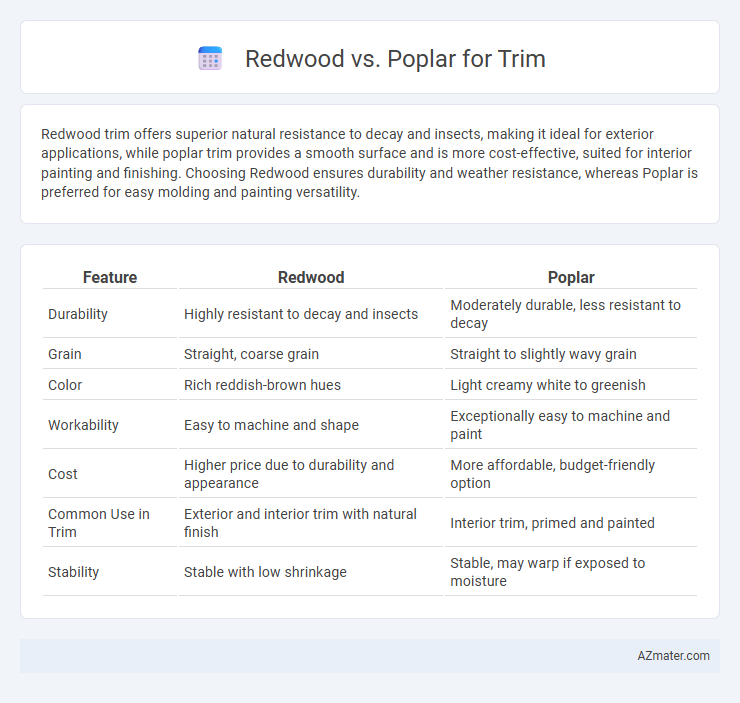Redwood trim offers superior natural resistance to decay and insects, making it ideal for exterior applications, while poplar trim provides a smooth surface and is more cost-effective, suited for interior painting and finishing. Choosing Redwood ensures durability and weather resistance, whereas Poplar is preferred for easy molding and painting versatility.
Table of Comparison
| Feature | Redwood | Poplar |
|---|---|---|
| Durability | Highly resistant to decay and insects | Moderately durable, less resistant to decay |
| Grain | Straight, coarse grain | Straight to slightly wavy grain |
| Color | Rich reddish-brown hues | Light creamy white to greenish |
| Workability | Easy to machine and shape | Exceptionally easy to machine and paint |
| Cost | Higher price due to durability and appearance | More affordable, budget-friendly option |
| Common Use in Trim | Exterior and interior trim with natural finish | Interior trim, primed and painted |
| Stability | Stable with low shrinkage | Stable, may warp if exposed to moisture |
Introduction: Redwood vs Poplar for Trim
Redwood offers natural resistance to decay and insects, making it a durable option for trim in exterior applications. Poplar is more affordable and features a smooth texture ideal for interior trim with paint finishes. Selecting between Redwood and Poplar depends on the project's location, budget, and desired finish durability.
Wood Characteristics: Redwood and Poplar
Redwood features a rich reddish hue with natural resistance to decay and insect damage, making it ideal for trim in moist or outdoor environments. Poplar offers a pale, neutral color with a smooth grain, allowing for easy staining and finishing, suitable for interior trim requiring paint or stain versatility. Both woods are lightweight and easy to work with, but Redwood generally provides superior durability and dimensional stability compared to Poplar.
Durability and Longevity Comparison
Redwood offers superior durability and natural resistance to decay, insects, and moisture, making it ideal for trim applications exposed to varying environmental conditions. Poplar, while easier to work with and more affordable, lacks the inherent weather resistance and tends to warp or deteriorate faster when exposed to moisture or pests. Choosing redwood trim ensures longer-lasting performance and reduced maintenance compared to poplar in both interior and exterior settings.
Workability and Ease of Installation
Redwood offers excellent workability due to its soft texture, making it easy to saw, nail, and sand for precise trim installations. Poplar, being a hardwood, provides better durability but requires sharper tools and more effort during cutting and shaping, which can slow down installation. Both woods finish well, but redwood's lighter weight and smoother grain make it more user-friendly for quick and efficient trim work.
Appearance and Grain Differences
Redwood features a rich, reddish-brown hue with a straight and fine grain, offering a warm and elegant look ideal for trim work seeking natural beauty. Poplar displays a lighter, pale greenish to creamy white color with a more uniform, somewhat wavy grain pattern, providing a smooth and consistent surface perfect for painted finishes. The contrasting grain and color characteristics make redwood suited for visible, stained trim, while poplar excels in applications requiring smooth texture and paint adherence.
Finishing Options: Staining and Painting
Redwood offers excellent staining options due to its natural rich red hues and tight grain, allowing for a smooth, even finish that enhances its natural beauty, while it also accepts paint well with proper priming to prevent tannin bleed. Poplar is highly versatile for finishing, especially favored for painting because of its uniform texture and minimal grain patterns, resulting in a flawless, smooth painted surface; however, it stains unevenly due to its porous nature and varying color tones. Choosing between Redwood and Poplar for trim depends largely on the desired final look: stain for showcasing natural wood aesthetics with Redwood, or paint for a crisp, clean appearance with Poplar.
Cost Analysis: Redwood vs Poplar
Poplar trim generally costs less than redwood, making it a budget-friendly option for interior applications. Redwood, prized for its natural resistance to decay and rich aesthetic appeal, carries a higher price point due to its durability and outdoor suitability. Cost analysis reveals poplar is ideal for affordable, paint-ready trim, whereas redwood justifies its premium price where moisture resistance and a natural finish are critical.
Environmental Impact and Sustainability
Redwood is a highly sustainable choice for trim due to its natural resistance to decay and insects, reducing the need for chemical treatments and extending product lifespan. Poplar, while fast-growing and renewable, often requires more intensive chemical processing and finishes, impacting its environmental footprint. Selecting redwood promotes forest conservation and lowers carbon emissions because it demands less maintenance and lasts longer.
Common Applications in Trimwork
Redwood is commonly used in trimwork for its natural resistance to decay and insects, making it ideal for exterior applications such as window casings and door frames. Poplar, favored for interior trim, offers a smooth surface that takes paint well, making it perfect for baseboards, crown molding, and decorative molding. Both woods provide versatility, with redwood suited for moisture-prone areas and poplar preferred for detailed, painted finishes in interior settings.
Conclusion: Choosing the Best Wood for Trim
Redwood offers superior durability and natural resistance to decay, making it ideal for trim in moist or exterior environments, while poplar's affordability and smooth grain make it a popular choice for interior trim and painting projects. Poplar's workability and consistent texture allow for easy customization, although it lacks the weather resistance and longevity of redwood. Selecting the best wood for trim depends on balancing durability needs and budget, with redwood preferred for long-lasting exterior use and poplar for cost-effective, paint-ready interior applications.

Infographic: Redwood vs Poplar for Trim
 azmater.com
azmater.com